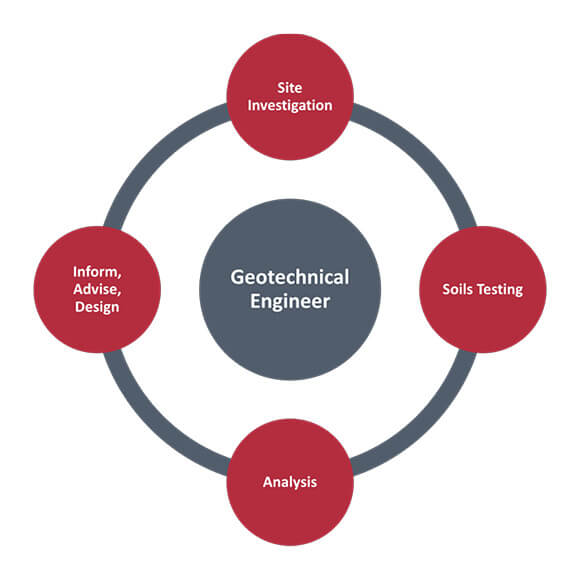The Ultimate Guide To Geotheta
The Ultimate Guide To Geotheta
Blog Article
The Ultimate Guide To Geotheta
Table of ContentsGet This Report about GeothetaRumored Buzz on GeothetaAn Unbiased View of GeothetaThe Best Strategy To Use For Geotheta
They collaborate with civil engineers, structural designers, engineers, and various other experts to integrate geotechnical considerations into the overall task layout and building and construction process. This requires efficient teamwork, coordination, and interaction to ensure that the geotechnical aspects straighten with the task objectives and meet governing demands.Mining & Materials Engineering: Principles of exploration, penetration rates, and variables impacting the choice of drilling method. Characteristics of dynamites, shooting systems and blast patterns. Blowing up techniques in surface area and underground workings. Unique blowing up techniques at excavation perimeters. Resonance and noise control. Mechanical and constant methods to fragmentation, consisting of longwall shearing and fullface boring.
Modelling of piece and fragment dimension circulations; comminution as a transfer function. Comminution modern technology: crushing, grinding, size classification. Integrated evaluation of fragmentation and comminution procedures. Offered by: Mining & Materials Design.
The Single Strategy To Use For Geotheta
Bachelor's level programs in civil, geotechnical, geological, and ecological design commonly last 4 years and include general education training courses in English, social scientific research, and the humanities, as well as courses in sophisticated mathematics, structural geology, and liquid mineralogy. (https://geotheta.carrd.co/)
Geotechnical engineering entails the evaluation of the dirt and rock conditions at a particular site, and their effects for the development of that website. As many frameworks depend on the ground for assistance, it lacks surprise that a comprehensive understanding of the ground conditions, and the viability of structure systems, are vital to the lasting security and performance of the building or framework.
Being experts in the investigation of geological developments and ground behaviour, geotechnical designers execute clinical investigations and testing to comprehend the effect these geological developments may have on the style and building of structure, civil and framework tasks. This experience is critical for the layout and construction of buildings, roads, tunnels, dams, bridges, and water system and sewer systems.
The geotechnical group at Douglas Allies routinely seek advice from with designers, design designers, designers, and builders to make suggestions on layout and growth propositions to make sure that the developed structures are appropriately developed for the ground conditions. The style of footing systems requires to take into consideration the weight of the structure, the capability of the ground to support that weight together with movement resistances and efficient building and construction.
Geotheta Fundamentals Explained
This task is significantly simplified by the use of our Douglas Map geospatial platform which makes this information readily easily accessible in a very easy to make use of web browser user interface. A geotechnical engineer will direct the drilling of boreholes and examination pits to collect soil and various other examples, and likewise evaluate surface area functions and ground exposures to form a geotechnical design of the subsurface problems.
Depending on the job kind and ground conditions experienced, laboratory screening may to name a few points evaluate toughness, compressibility, reactivity and/or leaks in the structure of dirt and rock samples. Hereafter data is accumulated and collected, the outcomes are utilized for a geotechnical model of the website, which is normally provided as areas across the website.

A geotechnical investigation naturally can just assess the ground conditions at the areas drilled or excavated. All-natural variants in dirt and rock problems can happen throughout a site and in between test areas. It is therefore good method that the geotechnical designer be maintained throughout construction of the project to provide on-site verification that the ground conditions come across are regular with the assumptions and advice offered in the geotechnical examination report.
Rumored Buzz on Geotheta
Geotechnical engineers use their comprehensive expertise of soil and rock to evaluate danger and address issues on diverse infrastructure projectsGeotechnical design is a specialist branch of civil engineering which takes a look at the behavior of planet materials and the application of soil and rock mechanics. Geo Tech Engineer. As a geotechnical engineer, you will analyze the physical, mechanical and chemical homes of soil and rock in order to develop foundations, maintaining frameworks and earthworks
Geotechnical engineering is carefully connected to and overlaps with, both design geology and ground design - https://profile.hatena.ne.jp/geotheta/. It's possible to be experts in geotechnics or work for a geotechnical company but be referred to as a design geologist or a ground designer. As a geotechnical engineer, you'll need to: construct and keep partnerships with clients and other professionals involved in the website, throughout each projectmaintain safety criteria on site be mindful of expense ramifications when you make recommendationsstudy geological maps and aerial pictures from a variety of resources and from various time periodsexamine construction intends to see exactly how practical they are based upon your understanding of the siteinvestigate threats or geological threats for the sitesearch for ecologically sensitive features, such as land fill begin to create accurate and interpretive ground modelsplan field investigationsdrill and analyse samples of bedrock, soil, groundwater and additional products oversee other professionals on sitesolve technical issues as they develop, such as unanticipated frameworks at drill sitesmonitor conditions throughout and after building to make certain structures are secure in the short and long termadding information gathered on website to your preliminary researchcreating geotechnical computations, illustrations, and two or three-dimensional computer system versions interpreting the datamaking recommendations about the suggested use the website

Report this page